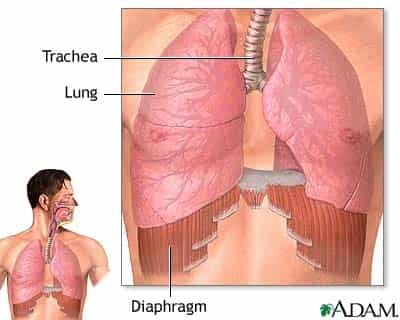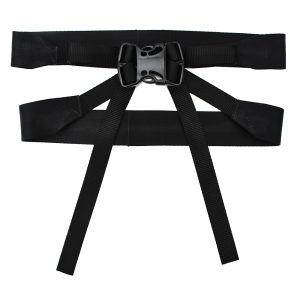How The Diaphragm Works
How The Diaphragm Works
The Singingbelt Vocal Techniques Make Breath Support Easy
MY SINGING TEACHER SAYS TO “SUPPORT YOUR VOICE” AND “SING FROM YOUR DIAPHRAGM.” WHAT DOES IT MEAN TO USE BREATH CONTROL? WHAT DOES THE DIAPHRAGM LOOK LIKE?

To understand the relationship between singing and breathing, it is first important to see what the diaphragm looks like and learn how it functions. The diaphragm is a large muscle sheath (pictured below and in video, right) that stretches across the bottom of the rib-cage, nearly cutting the body in half, separating the lower organs from the heart and lungs. During normal breathing, the diaphragm naturally flexes (or flattens) and contracts drawing air in and out of the lungs. “Supporting the voice” and “singing from the diaphragm” means flattening the diaphragm more deeply than during normal breathing and maintaining the diaphragm in that flattened position to control the release of air and the air pressure that streams across the vocal cords for phonation. To sing better, a vocalist must learn to preserve a reservoir of air in the lungs that supports and holds up a small amount of air released across the vocal cords.
A flattened diaphragm keeps a supply of air in the lungs which is used to “support” the air released with proper placement in the mouth for effortless singing. It holds the air in the body and gives the singer control of a resistant, steady breath. The air maintained in the lungs is the force and power underneath the breath released for sound.
If you think of a balloon filled with air, and the sound you can make by squeezing the lip at the top, it is only a small amount of air being released that makes a sound. It is the large amount of air maintained underneath it that gives the small amount of air its force to make sound. A large amount of air supporting a small amount of air – that is the definition of breath support. Once the balloon loses too much air, the sound dwindles, the pitch falls, and wavers until, even with some air left in the balloon, there is no sound, because there is no air pressure supplying a force to vibrate the lip of the balloon.
If the lower half of the rib cage is kept comfortably wide and the intercostal and lateral muscles are held in position, the resulting flattened diaphragm will support the breath. The abdominal wall muscles will expand as the ribs widen, and engage as the air is released in order to assist in this expansion. (This is why the design of the Singingbelt is so important. The angle of lower belt joining the upper belt at the breastbone ensures that the area of the diaphragm is targeted, but the abdominal wall muscles are not constricted in any way during your vocal warm-ups.*)

How the Diaphragm works
The diaphragm should be kept in a comfortably flattened position. There should be no tightening or tension. The singer is relaxed, holding the air in the body, not pushing air out or bearing down. The singer should feel as if the lower ribs are gently widening. During higher notes, and belting, the singer will feel the pressure of the air down into the abdomen. The Singingbelt gives immediate bio-feedback on the level of support the diaphragm is providing the voice. One directly feels if the intercostal muscles, as well as the obliques and lats are holding and keeping the diaphragm in position or if they have released. At the same time, the Singingbelt is designed not to constrict any of the abdominal muscles which aid in a steady, resistant breath needed for effortless singing.
* Breathing Exercise: The Singingbelt trains the whole core for diaphragmatic breath control. You many have heard of belly breathing and intercostal breathing. The Singingbelt works with the intercostals, the abdomen and the back. Try this simple breathing exercise before your vocal warm-ups:
Stand in a neutral position. Leave your mouth open and expand your belly and hold it. Some air comes in to the lungs, as you automatically inhale. Now, try again, same position, mouth open wearing the Singingbelt. Gently expand your lower ribcage against the belts. Careful not too push or tighten or take more air than feels comfortable to control. You will be using the intercostal, lateral, oblique and abdominal wall muscles. Feel the difference in the amount of air entering the lungs. It’s huge. Your belly has naturally expanded as well. Now, use the side of your fist as if you’re playing a trumpet, with resistance, blow out into your fist until all your breath is gone. At the end of your breath you’ll notice all your abdominal muscles engaging. All your core muscles are connected during singing. Controlling the breath comes from the control of the diaphragm which is located to the lower half of the rib cage. Blow into your fist again, only this time with somewhat less resistance. Feel the pressure in your lower abdomen. This is the pressure you should feel when you are belting or supporting higher notes. During high notes, or belted notes, you want to imagine the air is almost coming into the body to compensate for the tendency to push the note out of the body with a force of air. For healthy singing, you never want to push or force notes, it will strain the voice. If you balance the air, and create a close vocal cord resonance you should only have the sensation of pressure in the abdomen. As you blow into your fist, you will feel the sensation of breath support, the same sensation you want to feel when you are singing high notes, long phrases, belting, or even “screaming.”

